Rhabdomyolysis is a clinical and laboratory syndrome in which a person gradually breaks down muscle tissue, the decay products of which enter the bloodstream.
This disease is the most serious complication. when taking statins. Rhabdomyolysis is especially active in the presence of trauma, muscle inflammation, or infectious diseases. Currently, rhabdomyolysis is easily diagnosed by tests and treated by performing a comprehensive course of prescriptions aimed at eliminating the main symptoms of the disease.
Record content:
- 1 Views
- 2 Stages and degrees
- 3 Symptoms
- 4 Reasons for the appearance
- 5 Diagnostics
- 6 When to see a doctor
- 7 Prophylaxis
-
8 Treatment methods
- 8.1 Medications
- 8.2 Traditional methods
- 9 Possible complications
- 10 Video about rhabdomyolysis
Views
Rhabdomyolysis develops after myopathy when statins are taken in large quantities.
Today, there are several main types of the disease:
- hypoglycemia hypoketotic, in which the level of glucose in the blood decreases sharply. With this type of disease, the body begins to slowly break down muscle tissue as a result of the intake of statins. Decomposition substances actively enter the bloodstream, provoking a sharp decrease in the glucose level in the body. The patient feels a sharp deterioration in health, lack of strength and lethargy. Against the background of a decrease in immunity, rhabdomyolysis progresses, leading to muscle wasting;
- recurrent rhabdomyolysis, which is caused by mutations in genes and manifests itself from 7 liters. age;
- myopathy with a deficiency of type 2 carnitine palmitoyltransferase is also a genetic hereditary disease in which the body's processes of carnitine production are disrupted.
In the presence of a genetic predisposition to the disease, any intake of statins can provoke the development of rhabdomyolysis in various muscles. Several muscles can be affected at the same time, including those that are not connected to each other. If urgent medical care is not provided, waterlogging can actively progress, leading to disturbances in the functioning of the body as a whole.
Stages and degrees
When taking statins, rhabdomyolysis always proceeds in different ways and has several main stages.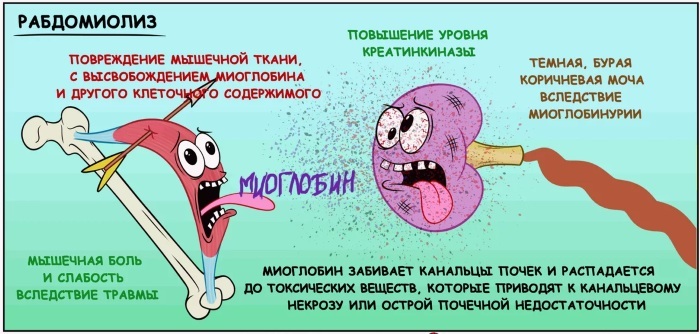
- A vivid manifestation of the disease is called the acute stage of rhabdomyolysis, which is treated with drugs and physiotherapy. At this stage, moderate and high degree of muscle pain and discomfort appear. Swelling and cyanosis may appear in the tissues. And the urine darkens due to the increased content of decay substances of muscle tissue in it.
- In rare cases, if complete recovery does not occur, the disease may reappear in remission.
The degree of development of rhabdomyolysis also varies:
- At an early stage of the course of the disease, signs of the disease and characteristic symptoms are completely absent. The patient feels tired and weak, with slight discomfort in the back. There is no swelling and blood and urine tests may show results within acceptable limits.
- In the middle stage, inflammation gradually develops in the muscle tissues. Soreness and swelling appear with slight muscle necrosis. At the middle stage, moderate and severe tissue necrosis appears, in which CPK (creatine phosphokenase) is more than 50 times higher than the norm;
- At the last degree of the disease, which is called clinical, muscle mycosis appears against the background of myoglobinuria and acute renal or renal failure. In difficult cases, the patient may suddenly fall into a coma.
Timely diagnosis of rhabdomyolysis is of paramount importance. At the initial stages of the disease, the treatment of the disease gives quick and positive results with the correct implementation of the prescriptions.
In the case of the onset of the last stage, rhabdomyolysis after treatment can lead to significant disruptions in the work of the whole body and cause chronic diseases. Therefore, when taking statins, it is recommended to constantly check the state of health of patients and undergo routine tests and examinations.
Symptoms
Rhabdomyolysis when taking statins in the early stages of development does not have pronounced external symptoms. Therefore, it is often confused with injury and bruises of muscles and ligaments, as well as overwork or decreased immunity.
However, a timely diagnosis can significantly accelerate the patient's recovery when such a disease, therefore the appearance of constant discomfort can signal the onset of development disease.
The primary symptoms of rhabdomyolysis are:
- back pain, especially in the lumbar region;
- weakness and fatigue;
- noise in ears.
At the next stage, as the level of creatine kinase in the blood increases, the following develop:
- local edema in muscle tissue;
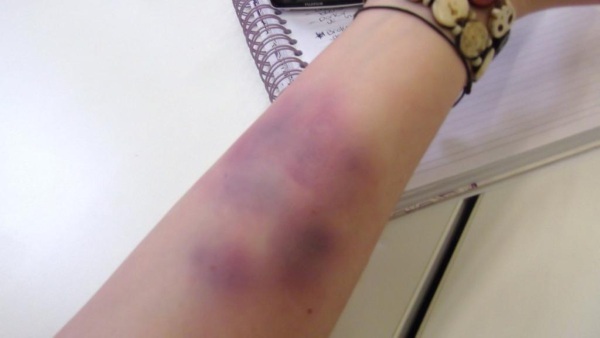
Rhabdomyolysis with statins causes muscle swelling and bruising - muscle pains appear;
- urine darkens and its amount decreases significantly.
At the last stage:
- the patient's urination is reduced to a minimum;
- renal and hepatic failure develops;
- severe pain is permanent;
- muscles and tissues around the damaged area swell as much as possible and may turn blue;
- the condition becomes critical and tissue necrosis causes inflammatory processes throughout the body.
Reasons for the appearance
Statins are trihydroxy-trimethylglutarylCoA reductase inhibitors that are most effective in lowering cholesterol synthesis in the body.
Statins are the most frequently prescribed drugs for diseases of the cardiovascular system and diabetes mellitus, which can dramatically reduce the total value of any type of cholesterol in the blood. After a course of taking the drug, LDL and HDL cholesterol decreases, as well as the level of triglycerides in the blood by 50%.
For the majority of patients, statins are absolutely safe and give optimal results with a course of therapy. To obtain a greater effect, individual patients are prescribed stronger drugs with a large dose of the drug component. As a result, the risk of side effects increases greatly, especially in certain categories of people.
It has already been established that taking statins in high doses for a long time, especially together with fibrate gemfibrozil promotes the development of myopathy, which leads to muscle weakness and muscle inflammation fabrics. In parallel, statins adversely affect the liver, which provokes severe conditions for the course of the disease.
Rhabdomyolysis occurs in a small number of patients. In just 0.04% of patients after taking statins, the development of rhabdomyolysis was recorded. However, when conducting such a study, certain categories of patients (women, children) were not taken into account, therefore the incidence rate is much higher.
Most often, along with the intake of statins, factors become the cause of the disease, which create a predisposition to active development of the disease, such as:
- constant strong physical activity;
- advanced age of patients, especially women;
- low body weight;
- diseases of the thyroid gland and liver;
- renal or renal failure;
- muscle injury;
- alcohol abuse;
- HIV infection.
Rhabdomyolysis with statins is a serious complication, therefore, at the planning stage of statin treatment, doctors it is necessary to correlate the benefits and harms of treatment and choose the optimal drug for a particular patient in order to exclude possible consequences.
Diagnostics
Since rhabdomyolysis at the first stage of the development of the disease after taking statins is often similar to a flu-like condition, it is almost impossible to diagnose the disease.
In the future, with the development of the disease and the appearance of pain in muscle tissue, edema, the orthopedic surgeon should prescribe a mandatory urine and blood test, which show not only the presence of inflammatory processes.
A general analysis of urine and blood will determine the activity of creatine phosphokinase and the appearance of myoglobin in the blood. If it is exceeded by more than 7 times the first indicator and the presence of myoglobin in any concentration, rhabdomyolysis is unambiguously diagnosed.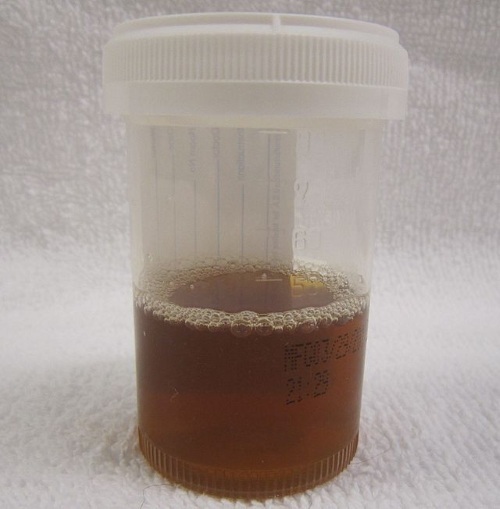
A general urinalysis will confirm the presence of inflammation. In urine with rhabdomyolysis, the level of protein increases significantly.
A general blood test, urine test can be taken in a regular clinic as prescribed by a doctor, as well as in medical laboratories. The cost of a urine test is 400 rubles, a blood test is 600 rubles.
To establish the stage of the course of the disease, the doctor prescribes ultrasound of the kidneys and liver, which will reveal the presence of violations in the work of these organs. In addition to the initial examination using ultrasound after 1 month. the patient is assigned a second ultrasound scan to monitor his health.
Ultrasound of the kidneys and liver is performed in a specially equipped office of a polyclinic or in a medical center that provides similar services. The cost of an ultrasound of the kidneys is 600-1000 rubles, the cost of the liver is 700-800 rubles.
To confirm the diagnosis, the patient must be examined by a neurologist who will check the state of reflexes and the nervous system. This examination can be done at a clinic or medical center. Its cost will be 500-700 rubles.
When to see a doctor
In most cases, patients taking statins do not develop health problems. And the correct dosage and the selected drug can significantly improve the health of an individual patient by lowering the level of cholesterol in the body.
In the case of the development of rhabdomyolysis when taking statins in the early stages of the course of the disease, it is almost impossible to make a diagnosis. Only after the appearance of discomfort (muscle pain and edema), patients are advised to visit an orthopedic surgeon and neurologist for a diagnosis. In the presence of injuries, the disease can be diagnosed by a surgeon or therapist.
An accurate diagnosis occurs after the delivery of basic tests and consultation with a neurologist and orthopedist, which can establish the development of rhabdomyolysis. An orthopedist, when clarifying the characteristics of a patient's health, is able to prescribe the necessary course of treatment and physiotherapy for a quick recovery.
With the rapid development of symptoms of the disease and a sharp deterioration in health, the patient must call an ambulance and further treatment if a disease is detected will be carried out in a hospital inpatient, under the supervision of several doctors.
Prophylaxis
Rhabdomyolysis with statins is considered the most difficult complication and rarely develops, but it can also be avoided.
As preventive measures, the following are used:
- timely treatment of injuries and muscle diseases;
- systematic delivery of urine during treatment with statins to monitor health status;
- exclusion during the period of treatment taking additional drugs, as well as alcohol;

- adherence to diet and exclusion of excessive physical exertion during the period of taking statins;
- personal control over your own health.
If all recommendations are followed, statins can only have a positive effect and improve health.
Treatment methods
In the case of diagnosing rhabdomyolysis, the patient is always assigned to rest at home and drinking plenty of fluids, subject to dietary intake.
Bed rest and the elimination of stressful situations are encouraged. Physical activity is completely excluded. The patient, depending on the state of health and analyzes, is prescribed a course of drug treatment, including inpatient treatment in a hospital at difficult stages of the course of the disease.
Medications
Treatment of rhabdomyolysis is always complex and affects the main symptoms of the disease.
| The main directions of treatment | Complementary treatment |
| cleansing the body of toxins | anesthesia |
| removing excess fluid | restoration of fluid balance |
| surgical intervention | maintaining the normal cardiovascular system |
Methods of dehydration of the body are used as the main means, when the patient is prescribed therapy to restore the level of fluid with useful substances in the body. In addition to pure water, the drug should include trace elements that quickly restore the desired balance.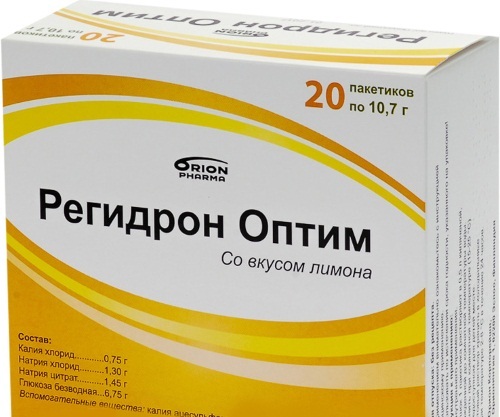
Rehydron is considered an effective remedy that maintains and restores fluid balance in the body:
- Dissolve 1 packet of rehydron in 1 liter of water and mix thoroughly before each dose.
- The solution is divided into 2-3 parts and drunk during the day.
The course of treatment is 5-7 days. The cost of 1 package of the drug is 30 rubles.
Oralit is actively used to restore fluid levels in the body.
- The drug must be diluted in 1.5 liters. water.
- Divided into 5-6 receptions, the solution is drunk during the day.
It is recommended to use the drug within 5 days. Oralite will allow you to quickly restore lost fluid, maintain and improve the existing metabolic balance in the body. Its cost is 400 rubles.
To cleanse the body of toxins, the patient is prescribed droppers up to 2 liters. on the day of saline (sodium chloride).
- Sodium chloride is administered through a dropper, starting from 500 ml for 30-40 minutes.
- The procedure is repeated after 3-4 hours, gradually bringing the total amount of the injected solution to 1.5 - 2 liters.
The blood is purified in this way for 3-5 days before the onset of a persistent improvement in the patient's health. Normal saline has been widely used for a long time to cleanse the body and restore blood circulation in rhabdomyolysis. The price of sodium chloride, 250 ml is 40 rubles.
At the same time, drugs are taken to eliminate edema and remove excess fluid from the body. Furasemide is effectively used for these purposes.
The drug not only significantly enhances the withdrawal of excess fluid, but also expands large veins, helping to reduce pressure on the heart. Adults take the drug 1 tab. 2 times a day or injected intravenously together with saline solution, 40 mg 1 time per day. The cost of packaging the medicine is 45 rubles.

In acute liver failure, mannitol is prescribed as a diuretic.
The drug is quickly absorbed and begins to act on the patient's body within 15 minutes. after taking. The medicinal components of the drug are almost not absorbed and are quickly excreted in the urine. The drug is administered intravenously at 1 g / kg and can be divided into 2-3 injections depending on the general condition of the patient. The course of administration is 3-5 days, and the cost of the medication is 80 rubles.
In acute renal failure, patients are additionally prescribed diuresis, which clears blood from tissue breakdown substances, urea and harmful substances before the onset of a general improvement in the condition the patient.
In case of severe pain in the muscle area, pain relievers are used. Ketarol is prescribed for adults according to a doctor's prescription for 1-2 tablets. 2-3 times a day with severe pain syndrome.
The effect of the drug begins within 30 minutes. and completely blocks any painful sensations. The cost of packaging is 250 rubles.
Analgin is widely used as an anesthetic.
Besides analgesic properties, it has anti-inflammatory and antipyretic properties. Drink it 1 ton 2-3 times a day or make intramuscular injections of 1 ampoule 1-2 times a day as needed.
When squeezing syndrome occurs due to swelling of muscle tissue, internal tissues and organs can suffer. In the case of severe tissue necrosis, urgent surgical intervention is also required.
In a similar situation, surgical excision of tissue (fasciotomy) is used at the site of edema to relieve pressure on the internal surfaces. In case of tissue necrosis, it is recommended to remove them in the last degree in order to prevent the onset of inflammatory processes in neighboring areas.
Traditional methods
In milder forms of the course of rhabdomyolysis, the treatment of the disease can be effectively carried out at home, additionally by means of traditional medicine, provided that medications are taken.
To remove fluid, viburnum and mountain ash juice is recommended:
- 10 grams of fresh viburnum and mountain ash berries must be chopped.
- The mixture is thoroughly squeezed through a sieve or cheesecloth.
- The finished juice is stored in the refrigerator and drunk in 1-2 tbsp. l. 2-3 times a day for 2 weeks.
The juice perfectly removes excess fluid from the body and helps to normalize the liver.
To improve the functions of the liver and kidneys and as a diuretic, celery and parsley are actively used:
- Celery and parsley greens in equal amounts are chopped with a blender or finely chopped with a knife.
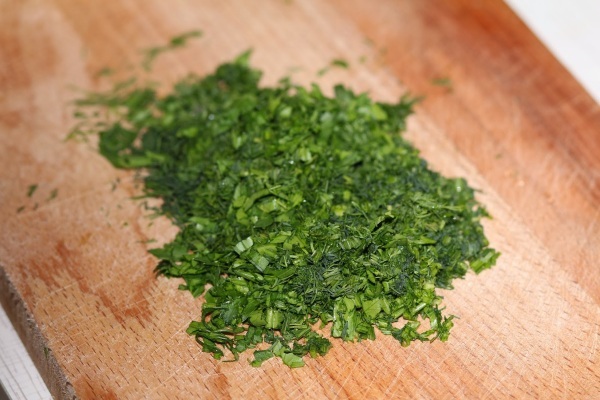
- The ready-made mixture should be eaten in 2-3 tbsp. l. with food, with a small amount of liquid. This should be done within 2 weeks.
- Only juice can be squeezed out of greens, which has a great effect. It is used in 1 tbsp. l. 1 hour before meals during the same time.
Herbs have an antiseptic effect in addition to a diuretic. They help to reduce inflammation and restore kidney function.
To relieve inflammation from the muscles, an ointment based on horsetail is used:
- Warm 30 grams of butter to room temperature.
- 2 tbsp. l. horsetail leaves are crushed with a blender or in a coffee grinder to a powder.
- Then the oil is mixed with the resulting powder.
- The resulting ointment is rubbed with a sore area and tightly tied with a woolen scarf. The procedure is repeated 2 times during the day in courses of 7 days. The finished ointment must be stored in the refrigerator until the next use.
Horsetail ointment has warming, anti-inflammatory and decongestant properties. It helps repair tissue at the site of injury by increasing blood flow to it.
Rubbing with herbal tincture has anti-inflammatory properties:
- For this, 2 tbsp. l. dry wormwood, pine buds, nettle, willow, sage and clover are crushed.
- Pour dry herbs into a bottle and pour 200 ml of vodka or 100 ml. alcohol.
- The tincture is kept in a dark place for 30 days, and then filtered.
- The prepared mixture is rubbed on the sore spot 3 times a day for 10 days.
Possible complications
Rhabdomyolysis while taking statins is a complex and dangerous disease, which can develop rapidly and provoke various complications:
- Most often, renal failure develops in the body, in which the kidneys gradually cease to function. Urine is not excreted from the body along with tissue breakdown products. In the absence of proper treatment, the patient can fall into a coma and die.
- Severe edema with rhabdomyolysis and swelling of muscle tissue cause local pressure on individual organs and bones. As a result, the work of internal organs can be disrupted, and bones can collapse. Failure to take action can damage internal organs and cause bones to break or become inflamed.
- Inflammation and necrosis of muscle tissue can cause inflammation in adjacent tissues and throughout the body. With a weakened immune system, HIV infection can be fatal.
- If untreated, rhabdomyolysis progresses, causing severe necrotic muscle lesions, which can lead to surgical removal of specific areas or tissues.
- In clinical cases, the manifestation of the disease in the absence of proper treatment can lead to death.
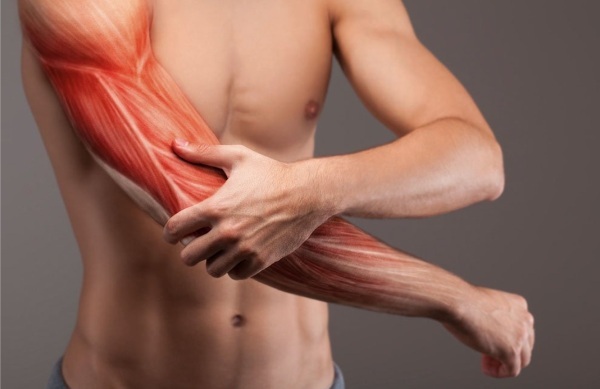
When taking statins at all stages of treatment, it is necessary to undergo control tests in order to monitor the state of health in general. In the case of timely diagnosis of rhabdomyolysis at an early stage, the disease is quickly and effectively cured with the help of drug treatment and restrictions on diet and exercise.
With periodic monitoring of well-being and choosing the correct dosage and type of drug, it is possible to completely eliminate the complication in the form of the development of rhabdomyolysis and completely restore health.
Video about rhabdomyolysis
Malysheva about rhabdomyolysis:



